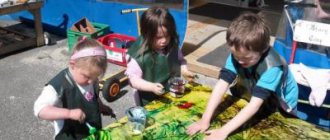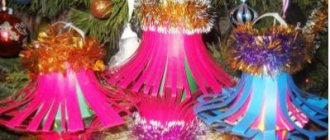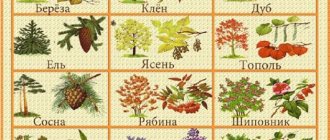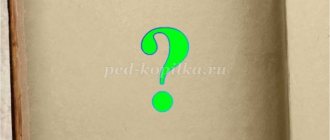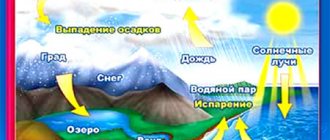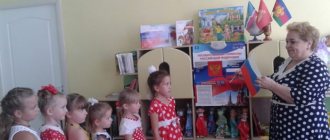Conversation “Birds of the Forest”
Conversation on the topic: “Who lives in the forest. Birds"
for children of senior preschool age
Target:
introducing older children to birds living in the forest.
Tasks:
teach children to distinguish forest birds by plumage, habits, and habitat; develop: visual memory, cognitive motivation, visual imaginative thinking, vocabulary; instill a love for nature.
Equipment:
computer, pictures of forest birds
Methodical techniques:
teacher's story about birds, viewing an electronic presentation, physical exercise "Bird", riddles.
Progress of the conversation:
— Guys, what time of year is it now? (Winter)
Today I invite you to go on a trip to the forest to get acquainted with the forest inhabitants - birds.
Slide No. 1
"Edge of the Forest"
- So we came to the forest edge. How many of you know what the phrase “edge of the forest” means (the edge is the place where the forest begins)
- How should you behave in the forest? (Quiet. Do not break branches, do not shout, do not scare the inhabitants of the forest)
Slide No. 2
“Forest” (a phonogram with birdsong sounds).
- Guys, what do you hear? Whose voices are these?
- Right. There are many different birds living in the forest. What birds do you know? (children's answers)
Slide No. 3
"Owl"
- Do you know this bird? (It's an owl)
— Is an owl a useful bird? How is it useful for humans?
(She catches mice in the fields that eat the grain, the harvest in the fields)
Slide No. 4
"Owls"
- these are her chicks. What are they called? (owls)
- Who can tell you about the owlets? What are they?
- they are funny, they have feathers down. Their beak and claws are already sharp. They need them in order to eat. The mother owl brings food (mice, frogs) in her beak, tears it into small pieces and feeds the chicks. The eyes are large and round.
Slide No. 5
"Forest"
- Guys, hear...Kuk-ku, kuk-ku! Who else lives in this forest?
(Cuckoo)
Slide No. 6
"Cuckoo"
— The cuckoo’s tail and wings are grey-gray. Stripes on the chest.
- Guys, do you know that the cuckoo itself does not hatch its eggs and does not feed its chicks? She lays her eggs in other people's nests. The egg is so similar to the other eggs in the nest that another bird incubates it.
— The cuckoo is also a useful bird; it feeds on hairy caterpillars that other birds do not like. This way the cuckoo saves many trees.
Fizminutka
The bird flapped its wings, the bird shook off its feathers,
She pulled her wings back, making a very important look.
She looked left and right and was surprised: “What’s the matter?
There’s not a single bird here, so I’ll fly home.”
She flew, flew, and sat down in her nest.
- What kind of bird is this? (children's answer) This bird can be seen not only in the forest, but also next to a person.
— People build houses for starlings. What are their names? (birdhouses)
- Why do starlings need them? (hatch chicks)
Slide No. 7
"Birdhouse"
- Guys, do you hear the drumming, as if someone is knocking on a drum? Who could it be? (Woodpecker)
Slide No. 8
"Woodpecker"
- Look what the woodpecker hollowed out with his beak. Why is he doing this? (This is how he gets insects and their larvae)
Slide No. 9
"Nightingale"
“But there’s a little gray bird sitting on a branch.” Its plumage is not bright, but it is the best singer of our forests. This is a nightingale.
Slide No. 10
"Teterev"
- Who knows what kind of bird this is? (grouse)
In the forests and copses of our vast country lives this beautiful black bird with red eyebrows and an unusual lyre-shaped tail. Her name is black grouse. Black grouse belong to the pheasant family. They lead a nomadic lifestyle, but in winter, flocks of grouse usually live in birch groves, where they feed on tasty birch buds.
Black grouse can dive very well. But not into the water, but into the snow. These birds spend the night in the snow, and in severe frosts they can sit in a snowdrift all day long, emerging only once a day for food. The black grouse has excellent hearing. If, while sitting in the snow, he hears the snow creaking under the paws of a fox or under the skis of a hunter, the black grouse instantly gets out of the snowdrift and flies away from danger.
Slide 11 “Crossbill”
— The crossbill is a bird, slightly larger than a sparrow. The beak of the crossbill is bent, its ends cross crosswise, overlap each other, as if it is tightly compressed. Thanks to this beak, the crossbill very deftly bends back the scales on the cones and takes out tasty seeds. Another peculiarity of this bird is that crossbills hatch their chicks in winter, in frosty conditions.
“We must not forget that it is winter now and the birds need help. How? (hang up feeders and feed the birds)
- Let's feed the birds too. (children complete the task of feeding the birds)
Bottom line.
Our journey is over. What birds did we meet today? What new did you learn? Did you enjoy the trip?
Bibliography:
1. Magazine “Pre-school education” No. 12 2010
2. Program by M. A. Vasilyeva, V.V. Gerbovaya, section “Child and the world around us”
3. Comprehensive lessons on the section “Social world”
Thematic week on the topic “Let's help birds survive the winter” in the preparatory group.
find? Goal: to summarize children’s knowledge about wintering birds ,
their needs; evoke in children sympathy and a desire to help them.
4.Getting to know the model «
Bird
"
.
Purpose: to clarify children’s understanding of the structure of birds .
Learn to use the iconic-symbolic diagram of the structure of birds
.
5.D/I “I’ll start, and you continue.” Goal: to exercise the ability to describe a bird according to certain characteristics, to consolidate the names of birds .
Walk
1. Situational conversation “What do birds eat?” invite children to watch the feeders, what birds fly in?, who has what habits?, what birds like what kind of food? Cultivate observation skills
2.P/I “The Kite and the Hen”. Exercise children in performing the “side gallop” step.
3. Outdoor game “Fourth odd”. Goal: develop the ability to classify birds ,
responding to the teacher’s mistake with certain movements.
4.Work assignment: Offer to pour bird food.
Goal: to cultivate a desire to help birds in winter
.
Evening
1. Conversation about migratory birds. Goal: to form a generalized idea of migratory birds ,
learn to distinguish them according to an essential feature: the ability to satisfy the need for food;
consolidate knowledge about the importance of birds in people's lives .
Enrich your vocabulary on the topic “Migratory birds
”.
2. Reading fiction: V. Bianki “Red Hill” (from the collection “Forest Were” - continuation).
3.D/I “Build a bird.” Goal: to practice the ability to build an image of a bird using geometric shapes.
4.D/I “Whose tail? Whose beak? Goal: to practice the ability to name birds based on external features.
5. Outdoor game “Wolf in the Moat”. Goal: continue to teach how to follow the rules of the game, act (imitate the movements of a wolf and geese) according to the chosen role and text.
THURSDAY
Morning.
1.Conversation
with children “Hello, winter-winter
.”
Purpose: to give an idea of winter phenomena that affect the life and behavior of birds
.
2. Didactic game “Who can name the most migratory birds .”
Goal: consolidate knowledge about migratory birds
.
3. Exercise for fingers to the text of I. Tokmakova’s poem “A Flock of Birds.” Goal: develop fine motor skills, memorize the text of the poem.
Walk
1. Observation of tits. They flew out of the forest in search of food. Write a comparative story about a tit. Consider their color. Tell them that they got their name because of their singing: “Xin - Xin.”
2. D/I “How many birds are there on the feeder?” Goal: to teach how to compose and solve simple problems on a visual basis.
3. Situational conversation “Do birds bring benefit or harm?”
Evening
1.D/I “Counting sticks”. Purpose: to practice the ability to make birds from counting sticks .
D/I "The Fourth Wheel". Goal: to develop children's attention and observation skills.
